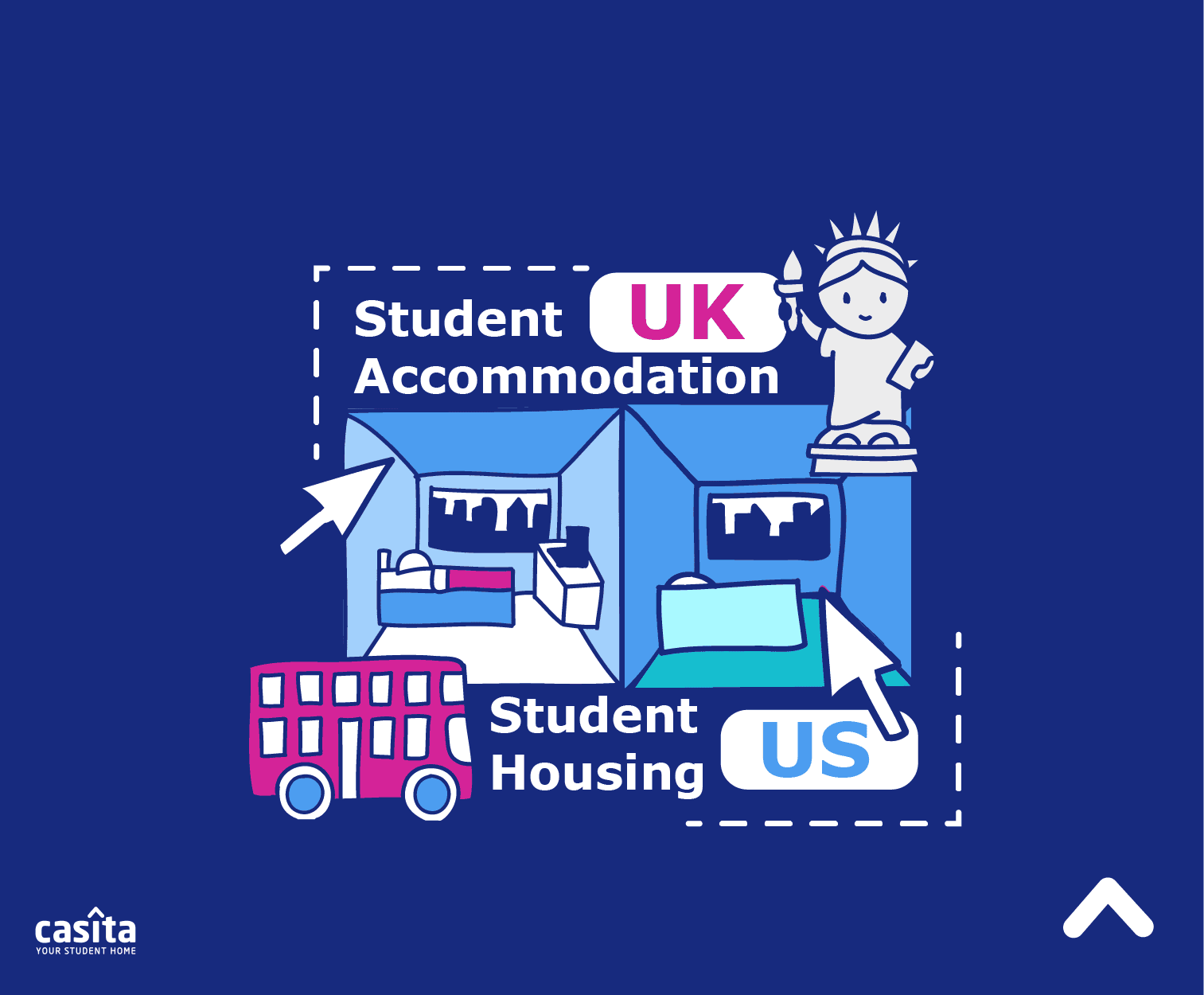Student Housing Statistics: A Case Study
Student Housing
Student Finance
11 mins read
Share

Updated at: 25 November, 2025
Published at: 31 July, 2023
By Reem Mohamed
Student Housing Statistics: A Case Study
Student Housing
Student Finance
11 mins read

Updated at: 25 November, 2025
Published at: 31 July, 2023
By Reem Mohamed
Share
The concept of student housing has been around for ages, taking a new form every now and then to adapt to the ever-changing needs of students everywhere. Starting with student cottages in the 1800s to modern-day’s student dormitories and PBSAs (Purpose-built Student Accommodation).
The student housing market is a competitive one that is naturally in high demand. Recently, student housing has emerged among the most in-demand asset classes in commercial real estate. This is mainly due to the surge in the number of international students as well as an increase in the middle-class demographic.
In 2018, the global investment in Purpose-built Student Accommodation exceeded $16 billion. In 2020, despite predictions that the COVID-19 pandemic will greatly affect the student housing sector of real estate, investment activity in PBSAs in the US totalled up to $1.58 billion.
A thorough, in-depth look into the statistics and general numbers behind the student housing market in all of its aspects is shared throughout the article, with emphasis on supply, demand, preferences, costs, and others.

The Student Housing Market: General Statistics and Insights
The student housing market has evolved greatly over the decades to become more in line with what students need. Adapting to meet the growing demand and the ever-increasing student population by taking on many different forms like PBSAs, on-campus residence halls, private rentals, and other shapes, the student housing market is expanding and adding to its offered amenities and services to cater to everyone.
Despite all the changes and improvements happening in the market, the demand suffers a slight decline in light of the COVID-19 pandemic.
Just about 22% of university students in the US live in on-campus residence halls and dormitories. 55% of university students in the country choose to live in other types of rental housing, while the remaining 23% live in off-campus housing, mainly PBSAs.
In 2020, however, in light of the COVID-19 pandemic hitting, the vacancy rate grew by 270 basis points to 7.9%.
Account for 12% of the total number of US rental units, student beds being rented and used up by students go up to 8.6 billion.
61% of the student housing beds, which is a majority of them, can be found in the South, while 19% are in the Midwest, 13% are in the West, and the leftover 6% can be found in the Northeast.
In 2018, the occupancy level of both on-campus and off-campus housing was estimated at 95%, indicating a consistent increase in the levels over the years.
During the COVID-19 pandemic, however, around 79% of officers for on-campus housing declared their institutions’ plans to maintain the existence of on-campus housing facilities and have them act as potential quarantine spaces.
In 2019, around 1,095,299 international students were enrolled in US universities and colleges, making them a key demographic for the student housing market in the United States.
The highest rate of international student enrolment in the country, according to international student housing statistics, is at New York University, which hosted 19,605 international students in 2019.
With international student enrolments dropping by 43% due to the pandemic, the demand for international student housing is also expected to drop.
Student Housing: Investments, Industry Leaders, and Market Size
Despite the ongoing pandemic and the post-pandemic period, the US student housing market remains strong and recovering whatever losses it had fast. When it comes to investment volumes, for example, the country has been and remains on the high side since 2010. Furthermore, the annual investments in student housing in the United States have reached almost $11 billion, which is triple what they were back in 2014. Below is a breakdown of additional student housing statistics, particularly those in relation to investments, industry leaders, and the overall market size.
As of May 2020, 1,066 loans that amounted to $18.2 billion were taken as mortgage loans by student housing property companies.
The student housing sector received a flow of cash of over $5.8 billion as capital in 2019.
Of the total investment in student accommodation, cross-border investment accounts for around 40%.
The rental student housing market, or particularly 55% of it, is estimated to be less than 10 units in size; that is for the 70 largest four-year universities in the United States.
However, at 80%, less than 50 units are offered by the majority of the rental stock for student housing.
With its plans to deliver a sum of 2,620 beds in 2020, the University of Illinois is considered the top location in the United States in terms of developing PBSAs (Private-built Student Accommodation).
Over the last 20 years, the student housing market has seen extreme growth, owing to the fact that the majority of the market, an exactly 78% of it, was built during that time period.
25 or more properties are owned by just under 20 companies in the student housing market.
With 169 properties and 104,078 beds, the top owner of student housing in the United States is American Campus Communities.
With around 500 basis points lower than the previous year, the student housing pre-leasing level for the fall semester of 2020 was estimated at 74.9% as of June 2020.
June 2020, however, in the same manner of increase as the year before, also witnessed about a 6% increase in month-over-month pre-leasing levels. This serves as an indication that throughout the time period between April and May 2020, the pre-leasing sector was recovering from a slump.

Student Housing: Supply Statistics
Continuing at a steady rate, on-campus and off-campus housing facilities are seeing developments. Student housing statistics, on the other hand, are providing a number of interesting insights in terms of supply. In the southern US, for example, colleges and universities tend to offer the highest number of off-campus beds. While in the northeastern US, students can always count on universities and colleges in the area to have a higher availability of on-campus beds. Here are some of the interesting supply statistics in the student housing market.
By 2021, the estimated number of student housing beds in the US is said to be around a rough total of 2.48 million.
A total of around 47,000 beds are expected to be added by universities and colleges in the US for their students.
Only 21.5% of undergraduate students at the country’s 175 largest universities are provided with on-campus housing.
On average, the estimated off-campus bed-to-total enrolment ratio is around 16.9%.
Only 39,000 beds, however, are forecasted to be occupied by students in 2021, as it’s expected to be a relatively quiet year.
The highest number of off-campus beds goes to Florida State University, which has an off-campus beds-to-total enrolment ratio of 69.1%.
The least number of off-campus beds per student, disregarding the universities that do not offer off-campus beds for their students, is the 182 off-campus beds that are offered by the University of California - Los Angeles for its 33,317 students.
A stunning on-campus bed-to-total enrolment ratio of 76.6% is presented by Eastern Illinois University, which is the university offering the highest number of on-campus beds per student.
The university offering the least number of on-campus beds per student, setting aside any and all universities that do not offer on-campus beds, to begin with, is California State University Fresno. This university offers just around 1,100 on-campus beds for its 25,168 enrolled students.

Student Housing: Demand Statistics
In 2020, while occupancy rates in student housing are still going at a steady rate, the demand might fall on the lower side compared to previous years, This is due to multiple factors, a notable one being the decision made by some schools to hold online classes rather than on-campus ones. This is not always the case, though; for some, the demand has barely shifted from shared rooms to private ones in light of the pandemic. Some demand statistics are as follows:
The number of students that require rental housing in close proximity to their university or college campus is around 8.6 million.
High enrolment growth is seen in universities with 100% occupancy. Boise State University, for example, had an enrolment growth of 5.7% in 2018 and reported a 100% occupancy rate.
In August, the lowest pre-leasing rates were reported at 80.3%, courtesy of the University of Alabama.
The overall purchasing behaviour of students indicated a decrease of around 71% in lower-cost books. This is mainly due to the shift n student housing demand from shared to private rooms during the pandemic, leading to more students opting to pay more just to get a private room.

Student Housing: What Students Prefer
When it comes to their living spaces at university and the amenities attached to these living spaces, students have their own preferences and opinions. These preferences often include a variety of useful and handy features like security and safety features, location and proximity to campus, technological features, and so much more. High-quality student housing has been highly in demand recently and it makes a compelling case for the best use of real estate management software.
The availability of high-quality student housing has affected the decisions of more than 78% of university students when choosing their college or university.
The three top amenities at student housing properties that were ranked the most important according to students are as follows: Wi-Fi at 78%, laundry facilities at 77%, and all-inclusive utilities at 71%.
Adapting to Students’ Needs and Preferences: Smart Additions to Student Housing Amenities
Students want their time at university to be memorable and of great value, not just through education, but also through additional experiences throughout their study journeys. This leads to students from all around the world wanting to choose the perfect student housing property that is high in quality and comes with all the facilities, amenities, services, and communities that are meant to elevate their overall experience.
According to a survey conducted by Knight Frank in partnership with UCAS in the UK, accommodation is an important support factor for students’ well-being and both existing and new and up-and-coming student housing operators need to respond accordingly.
Additionally, the generational shift from millennials to Gen-Z has caused a notable shift in what amenities and services are currently in demand at student housing facilities. New additions like tech-powered study nooks that double as social spaces, co-working spaces fitted with Wi-Fi and screens, Uber pickup spots, pickup and dropoff spaces for food deliveries, fitness facilities, and even fresh markets are being considered as smart moves towards improving students’ overall living experience in a student housing facility in the United States.
Some universities have even started taking initiatives and partnering with known brands to provide students with stellar services throughout their stay. The University of Texas, for instance, is incorporating mobility solutions into its housing facilities through a pilot partnership with Uber’s JUMP bicycles that enables outfitting ACC properties with JUMP bicycle-charging stations.
Finances: Student Housing and Rent Costs
Student housing costs in the United States are typically on the expensive side, even more so now that luxury apartments are spreading in the areas surrounding college and university campuses. The cost of housing and rent for college students are affected by a number of different factors, including how close a property is to the campus, as well as the amenities and services provided by the said property. Moreover, costs tend to be a bit higher and more expensive at privately-owned properties.
Living expenses are usually among the top reasons mentioned in lists and statistics concerning why people do not go to college; this is mainly due to the huge toll the increasing costs of student housing have on college students and the heavy burden it is, especially for those facing higher tuition fees.
$7,717 per bed is the average student housing rent per year for on-campus residence halls costs.
In opposition to the annual average rent for on-campus apartments which is $7,056, the rent per year for off-campus purpose-built student housing is around $10,965.
Student-competitive off-campus housing is usually associated with the highest rent costs per year, falling at an estimate of $13,093.
While the rent for student housing grew in 2018 at a rate of 1.6%, its growth in the fall of 2019 was estimated at 1.8%.
Location affected the rent growth in 2019; student housing properties located less than half a mile from campus saw a growth rate of 2.1%, while housing properties located more than a mile from campus grew at a rate of only 2.1%.
Purpose-built student accommodation cost the student less than student-competitive housing. Students paid 9% more per year for student-competitive housing than they would have for purpose-built housing.
26% less pay was dedicated to renting an on-campus apartment compared to an off-campus purpose-built student housing unit.
For every additional mile away from campus, a 17% discount was brought for students renting a purpose-built student housing unit.
Another comparison presents itself, this time between private-school accommodation and public-school accommodation, with the latter costing an annual per-bed rent of $7,553 and the former costing more, at an estimate of $8,148.

Is Off-Campus Housing Cheaper?
In a survey where 48 places were looked at in order to answer this question, 28 of them proved that it’s the same price or even cheaper to live off-campus, with the average savings amounting to almost $220 for those living with a roommate.
Of those 28 places, 8 had meals included in the housing plans. Disregarding these places from the overall calculations, the average monthly savings in off-campus accommodation goes down to $146.
If the advantages of off-campus housing are slim, utility costs can be a dealbreaker. This is mainly because utilities are often included in on-campus housing rents and typically not included in off-campus housing rents.
At Ball State University in Muncie, Indiana, students pay the highest premium to live in an on-campus facility, an additional $707 every month compared to living in an off-campus apartment with a roommate, the only difference being that on-campus housing comes with meal plans.
Excluding meal plans, the other 20 places where on-campus housing has been reported as cheaper than splitting an off-campus two-bedroom apartment have reported monthly savings of around $221.
The largest savings margin students can achieve is if they are enrolled at California Polytechnic State University, where living on campus saves them around $636 per month, while living in an off-campus two-bedroom apartment costs around $1,553 per person.
Student Housing Costs: Does Location Matter?
Whether or not the student housing property’s location or the university’s location affects the overall cost has been up for debate. The following statistics shed some light on the matter.
The highest off-campus housing costs per month are reported in Berkeley, California, and are estimated at $2,263. Tallahassee, Florida, on the other hand, reports the lowest monthly costs for off-campus housing, sitting at just $593.
Berkeley, California also holds the spot for the highest on-campus monthly housing costs paid by students at $1,861. The lowest on-campus monthly housing costs, however, are courtesy of students in Provo, Utah, who pay just around $417.
The highest rent growth reported in 2019 was an estimated 7.5% increase at Bowling Green State University in the state of Ohio.
In large city urban areas, student beds usually have a 56% premium for student-competitive units, a 52% premium for on-campus options, and a 32% for purpose-built student accommodation options.
Student Housing Market: What Does the Future Hold?
Through recession periods, the student housing market has a shining quality that allows it to maintain a steady demand throughout. The support for this comes from the findings that after a brief disruption during the onset of the pandemic, pre-leasing levels are getting back on track. Additionally, many international students have chosen to stay in the United States and continue living in and leasing their student housing, even with classes being held online. These are the qualities that ensure a stable growth for the student housing market.
The student housing market in the United States seems to have a particularly positive outlook in its future, as demand is expected to stay at the same rate moving forward. Tighter competition among property developers and consistent yields for student housing are among the factors that contribute to the current state of the student housing market in the United States.
40% of investment in student accommodation over the last three years was accounted for by cross-border capital into student property markets around the world. As currently existing student housing operators in mature markets are looking to expand and build scale, brand, and reputation in emerging markets, the level of active capital globally is expected to rise. Large-scale truly global owner-operators are expected to emerge in the next decade.
The continuous and astounding growth of the middle class globally is one of the major factors driving the demands for all goods and services, and education is no expectation. This, in turn, is the main cause for the increased number of students choosing to study outside their home country over the last five years; this rise is estimated at 23%. By 2025, the global mobile student population is expected to increase up to 8 million after its rise to 5 million in 2019, as forecasted by the OECD, the Organisation for Economic Co-operation and Development.
These statistics, however dynamic and bound to change, call for a bright future for higher education in general and the student housing market in particular but are not barred from the occasional issues that come with future success and prosperity.
Student Housing
Student Finance
By Reem Mohamed
Share
Student Housing
Student Finance
Updated at:
Published at:
By Reem Mohamed
Share


